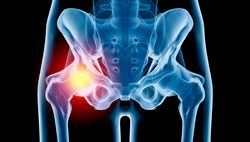
Hip Joint
The hip joint is one of the most important and flexible joints in the human body which allows us to walk, run, bend and perform physical activities. It is a ball (femoral head) and socket joint formed between the hip bone and femur (thighbone). It is surrounded by strong muscles and tough ligaments that prevent its dislocation.
Hip Injuries
The hip joint is prone to several types of injuries. Common ones include:
Fracture
A hip fracture is a break that occurs near the hip in the upper part of the femur or thighbone. It is most frequently caused after low energy trauma in elderly patients, and by a high-energy trauma or serious injury in young people. Long-term use of certain medicines, such as bisphosphonates to treat osteoporosis and other bone diseases, can increase the risk of hip fractures.
Bursitis
This is a painful condition caused by inflammation of a bursa in the hip. Bursae are fluid-filled sacs present around joints between bone and soft tissue to reduce friction and provide cushioning during movement. The bony prominence of the hip is called the greater trochanter and is present on the outer side of the femur. The bursa overlying it is called the trochanteric bursa. Another bursa is located towards the groin region and is called the iliopsoas bursa. Trochanteric bursitis is the more common of the two conditions.
Dislocation
This occurs when the head of the femur moves out of the socket. The femoral head can dislocate either backward (posterior dislocation) or forward (anterior dislocation). Hip dislocation can be caused by injuries from motor vehicle accidents or severe falls.
Labral tear
This is an injury to the labrum, the cartilage that surrounds the outside rim of your hip joint socket. A tear in the labrum of the hip can result from traumatic injury, such as a motor vehicle accident or from participating in sports such as football, soccer, basketball, and skiing. Repetitive movements and weight-bearing activities over time can lead to wear-and-tear and degenerative changes to the hip joint in older patients.
Snapping Hip Syndrome
This is a condition in which you hear or feel a snapping sound in the hip while swinging your legs, running or walking, or while getting up from a chair.
Diagnosis
Diagnosis of a hip injury often begins with a history and a physical examination. Your doctor may ask you questions related to your general health and any history of accidents or injuries. You will be asked to perform various range-of-motion exercises to replicate your pain. Most patients experience acute pain with weight-bearing and active range of motion, and minimal pain when the doctor moves the hip for them (passive range of motion).
You will also be recommended to undergo imaging studies such as X-rays, or more rarely CT scans or MRIs to confirm the diagnosis and determine the exact location of the injury.






